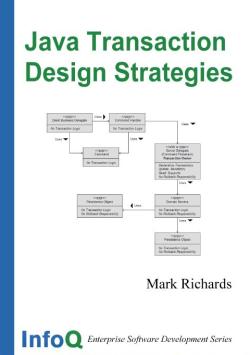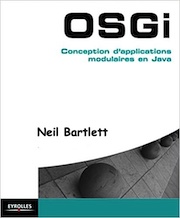
|
FreeComputerBooks.com
Links to Free Computer, Mathematics, Technical Books all over the World
|
|
- Title Java Transaction Design Strategies
- Author(s) Mark Richards
- Publisher: Lulu.com; eBook (InfoQ.com)
- Hardcover/Paperback: 116 pages
- eBook PDF (117 pages, 1.7 MB), ePub, and MOBI
- Language: English
- ISBN-10: 1411695917
- ISBN-13: 978-1411695917
- Share This:

|
Understanding how transaction management works in Java and developing an effective transaction design strategy can help to avoid data integrity problems in your applications and databases and ease the pain of inevitable system failures.
This book is about how to design an effective transaction management strategy using the transaction models provided by Java-based frameworks such as EJB and Spring. Techniques, best practices, and pitfalls with each transaction model will be described. In addition, transaction design patterns will bring all these concepts and techniques together and describe how to use these models to effectively manage transactions within your EJB or Spring-based Java applications.
The book covers: - The local transaction model - The programmatic transaction model - The declarative transaction model - XA Transaction Processing - Transaction Design Patterns
About the Authors- Mark Richards is Certified Senior IT Architect at IBM, where he is involved in the architecture and design of large-scale Service Oriented Architectures in J2EE and other technologies, primarily in the financial services industry.
- Java Enterprise Applications
- Advanced Java Programming
- Introduction to Java Programming
- Java Build, Testing, and Deployment
 Similar Books:
Similar Books:
-
 Guide to Java Persistence and Hibernate (S. Hennebrueder)
Guide to Java Persistence and Hibernate (S. Hennebrueder)
This book is for Java developers who want to learn about Hibernate. It provides a clear introduction to the current standard for object-relational persistence in Java, with more in-depth examples than any other books for Hibernate beginners.
-
 Java Persistence (Wikibooks)
Java Persistence (Wikibooks)
This book is meant to cover Java persistence, that is, storing stuff in the Java programming language to a persistent storage medium. Specifically using the Java Persistence API (JPA) to store Java objects to relational databases.
-
 Dynamic Proxies in Java (Heinz M. Kabutz)
Dynamic Proxies in Java (Heinz M. Kabutz)
Dynamic proxies are such a tool that we can use it to save thousands of lines of repetitive code with a single class. This book is for intermediate to advanced Java programmers who want to get to "guru" status. It is not suitable for beginners in Java.
-
 High-Performance Java Platform Computing
High-Performance Java Platform Computing
Threading and concurrency are crucial to building high-performance Java applications. This book thoroughly demystifies them, helping developers leverage threading and concurrency to solve a wide variety of performance problems.
-
 The Java Web Scraping Handbook (Kevin Sahin)
The Java Web Scraping Handbook (Kevin Sahin)
This book will teach you how to extract data from any website, how to deal with AJAX / Javascript heavy websites, break captchas, deploy your scrapers in the cloud and many other advanced techniques, using Java programming language.
-
 Naked Objects (Richard Pawson, et al)
Naked Objects (Richard Pawson, et al)
The aim of this book is to introduce you to the concept of designing business systems from naked objects, and to enable you to start building such systems using the Naked Objects framework. It outlines a lightweight methodology and provides a short tutorial.
-
 Object-Oriented vs. Functional Programming (R. Warburton)
Object-Oriented vs. Functional Programming (R. Warburton)
This book discusses similarities between these programming paradigms and points out that both FP and OOP are actually moving closer toward one another. One prominent example is the use of lambda expressions in Java and other OOP languages.
-
 Docker for Java Developers (Arun Gupta)
Docker for Java Developers (Arun Gupta)
This book introduces basic Docker concepts and explains how to achieve faster startup and deployment of your Java‑based applications, shows how Docker containers can save you many headaches when it comes to packaging, deploying, and scaling your applications.
-
 OSGi In Practice (Neil Bartlett)
OSGi In Practice (Neil Bartlett)
This book is a comprehensive guide to OSGi with two primary goals: first introducing to OSGi concepts with examples, then exploresing numerous practical scenarios and techniques, as well as answering questions.
-
 Building Reactive Microservices in Java (Clement Escoffier)
Building Reactive Microservices in Java (Clement Escoffier)
This book is for developers and architects interested in developing microservices and distributed applications. It does not explain the basics of distributed systems, but instead focuses on the reactive benefits to build efficient microservice systems.
-
 Java Authentication and Authorization Service (JAAS) in Action
Java Authentication and Authorization Service (JAAS) in Action
By the end of this book, you will both understand and use the functionality in JAAS, and also be able to replace many of the pieces provided by the JDK or whatever application server you may be using with your own custom classes.





